GSTR-9 is a summary report that businesses file annually, consolidating details of their sales, purchases, tax liability, and input tax credit for the entire financial year.
Download Form GSTR-1, Form GSTR-3B, Form GSTR-9 Summary and Table 8A Document Details
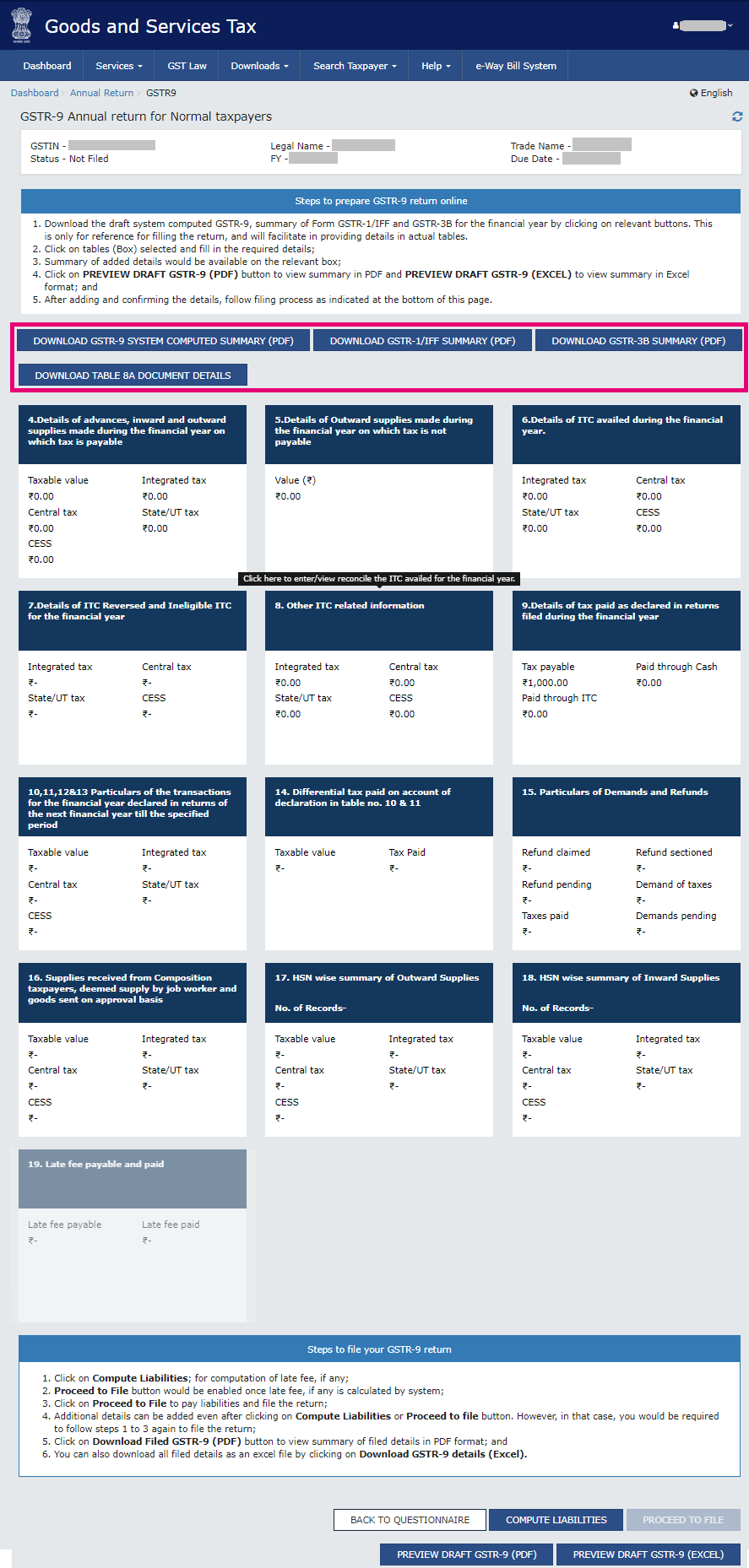
- GSTR-1/IFF Annual Summary: Contains consolidated information on outward supplies for each month.
- GSTR-3B Annual Summary: Total of all GSTR-3B, providing an overview of tax liabilities and payments.
- Table 8A Documents of GSTR-9: Breakdown of ITC availed, specifying details of each document.
- System Computed GSTR-9 Summary: A computed overview of annual outward and inward supplies, tax liability, and input tax credit.
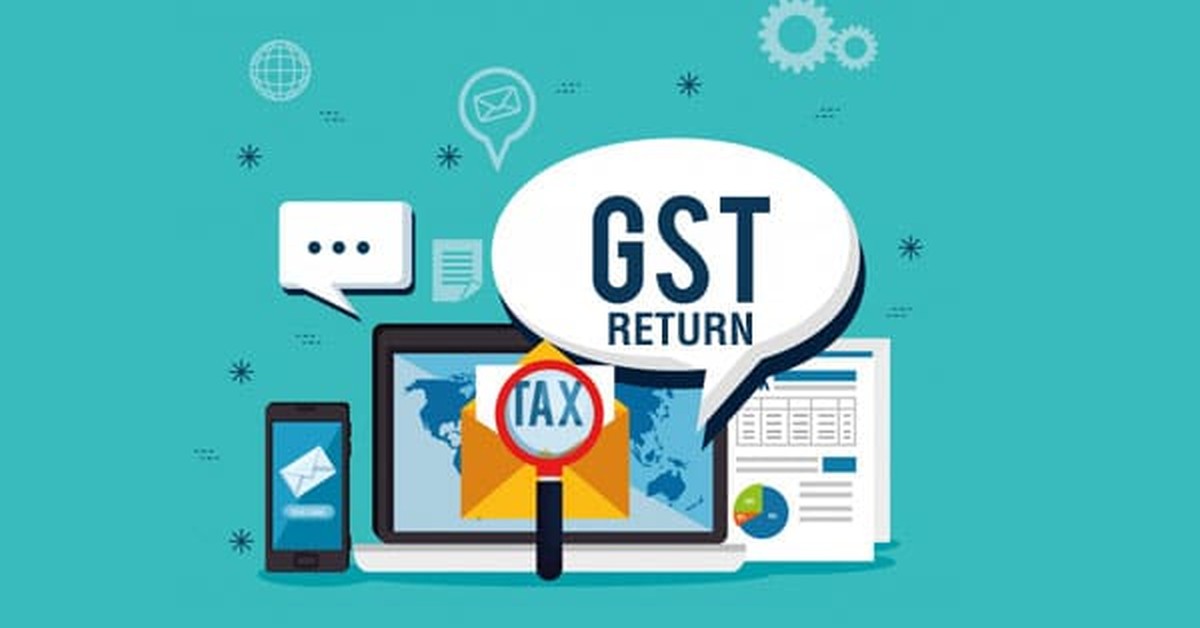
Details required to be furnished
Table 4: Details of advances, inward and outward supplies made during the financial year on which tax is payable
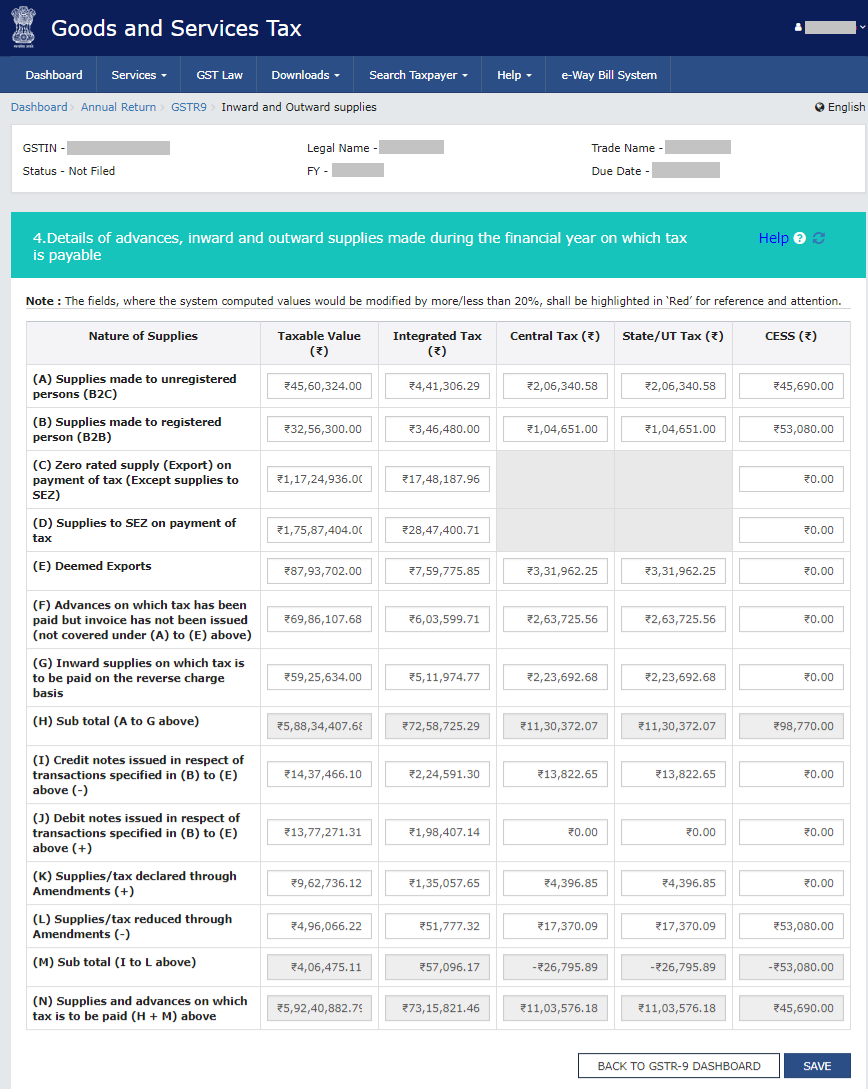
Illustration
A. Aggregate value of tax-paid supplies to consumers and unregistered persons.
B. Aggregate value of tax-paid supplies to registered persons (including through E-Commerce operators).
C. Aggregate value of exports with tax payment.
D. Aggregate value of supplies to SEZs with tax payment.
E. Aggregate value of tax-paid supplies classified as deemed exports.
F. Uninvoiced advances with tax payment (positive figure for current year, negative for prior years).
G. Aggregate value of inward supplies where recipient pays tax (including imports and supplies from unregistered persons).
H. Sub Total to A to G
I. Aggregate value of credit notes for B2B, exports, SEZ supplies, and deemed exports.
J. Aggregate value of debit notes for B2B, exports, and SEZ supplies, and deemed exports.
K. Details of increased supplies or tax through amendments.
L. Details of reduced supplies or tax through amendments.
M. Sum of amendments made to various categories.
N. Total value of supplies and advances on which tax is to be paid (Sum of H and M).
Table 5: Details of Outward supplies made during the financial year on which tax is not payable
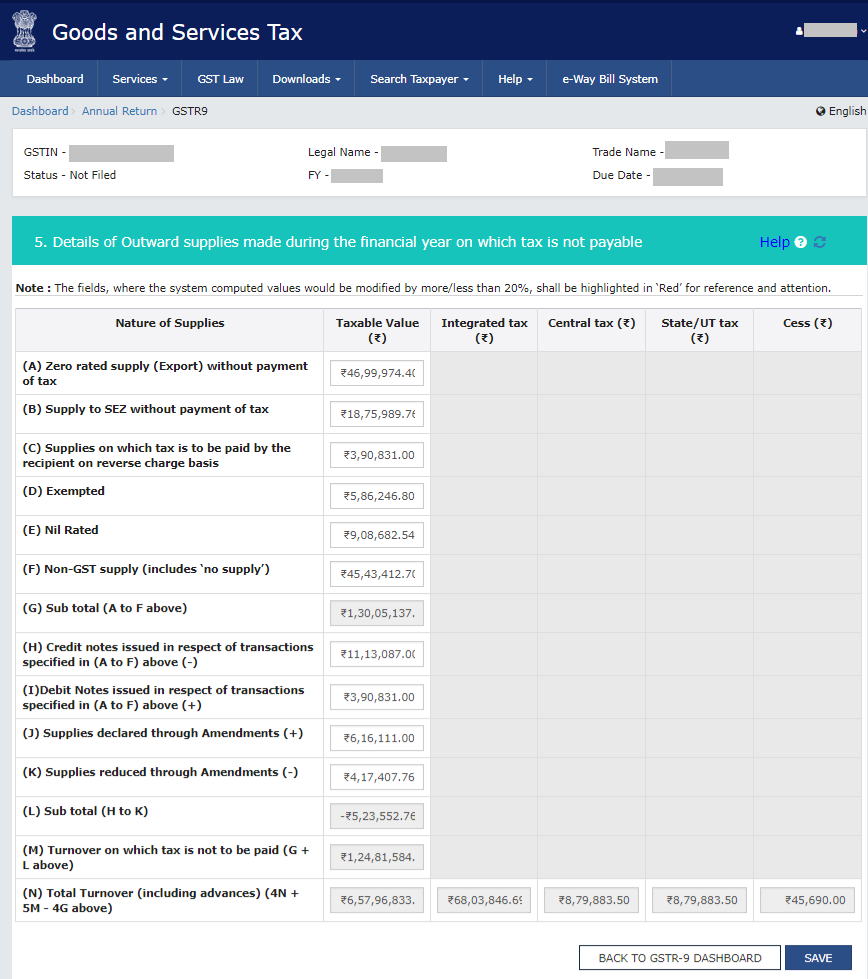
Illustration
A. Aggregate value of exports (except to SEZs) where tax has not been paid.
B. Aggregate value of supplies to SEZs where tax has not been paid.
C. Aggregate value of supplies to registered persons where recipient pays tax on reverse charge basis.
D. Aggregate value of exempt supplies made during the financial year.
E. Aggregate value of supplies taxed at nil rate during the financial year.
F. Aggregate value of non-GST supplies made during the financial year.
G. Sum of values from A to F.
H. Aggregate value of credit notes for supplies in A to F.
I. Aggregate value of debit notes for supplies in A to F.
J. Details of increased turnover through amendments.
K. Details of reduced turnover through amendments.
L. Total from H to K
M. Turnover on which tax is not paid (Sum of G and L).
N. Total turnover, including advances (Sum of 4N and 5M, minus 4G).
Table 6: Details of ITC availed during the financial year
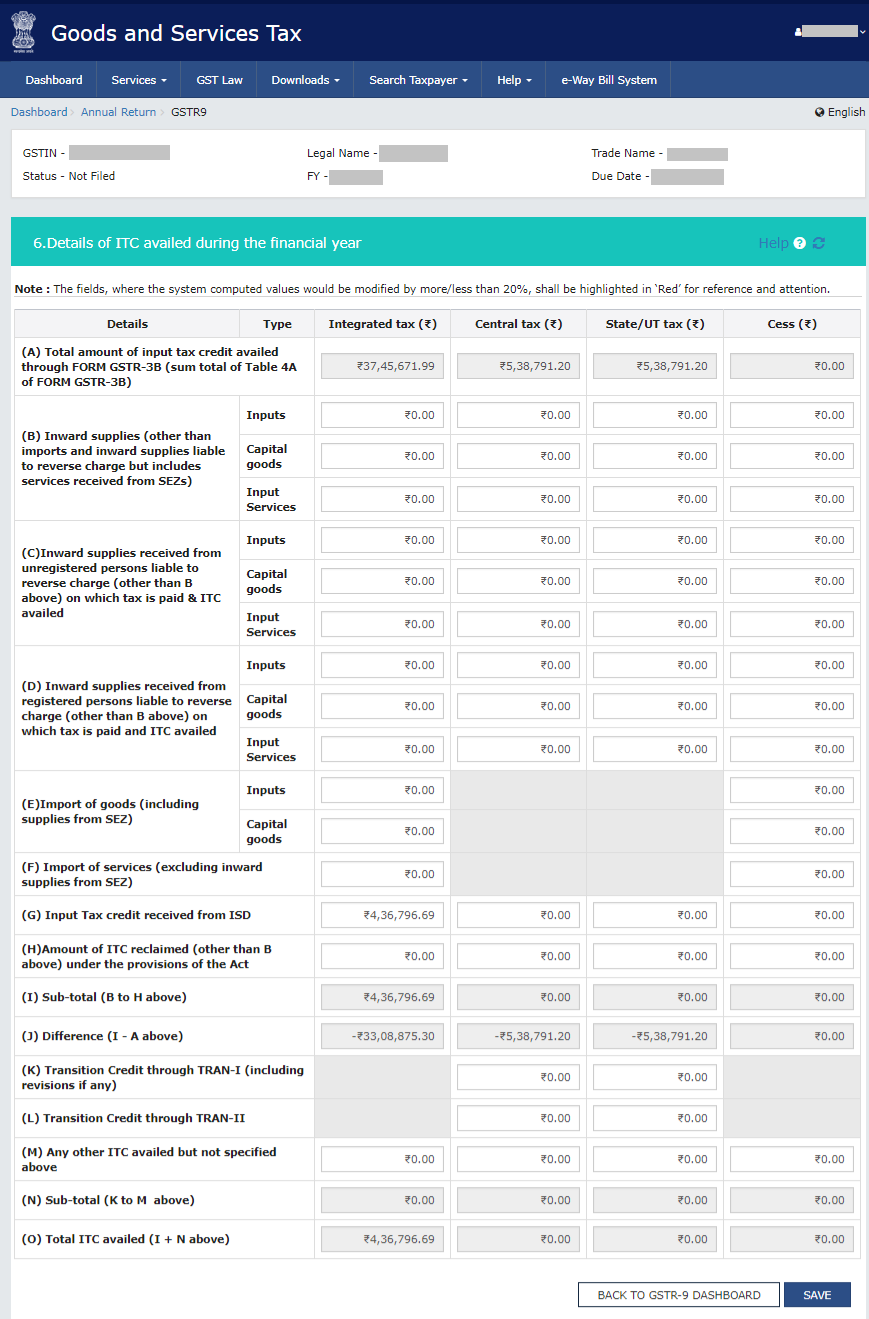
Illustration
A. Auto-populated total input tax credit from GSTR-3B Table 4A.
B. Aggregate value of input tax credit on all inward supplies, excluding reverse charge and SEZ services.
C. ITC availed on inward supplies from unregistered persons under reverse charge.
D. ITC availed on inward supplies from registered persons under reverse charge.
E. ITC details on imported goods, including supplies from SEZs.
F. ITC details on imported services, excluding those from SEZs.
G. Aggregate value of ITC received from ISD.
H. Aggregate value of ITC reclaimed under the provisions of the Act.
I. Sum of values from B to H.
J. Variance between GSTR-3B ITC and Sub-total (Ideally zero).
K. Details of transition credit received through TRAN-I, including revisions.
L. Details of transition credit received through TRAN-II.
M. Details of ITC availed not covered in B to L, including FORM ITC-01 and FORM ITC-02.
N. Sum of values from K to M.
O. Overall total of ITC availed, combining sub-totals I and N.
Table 7: Details of ITC reversed and Ineligible ITC for the financial year
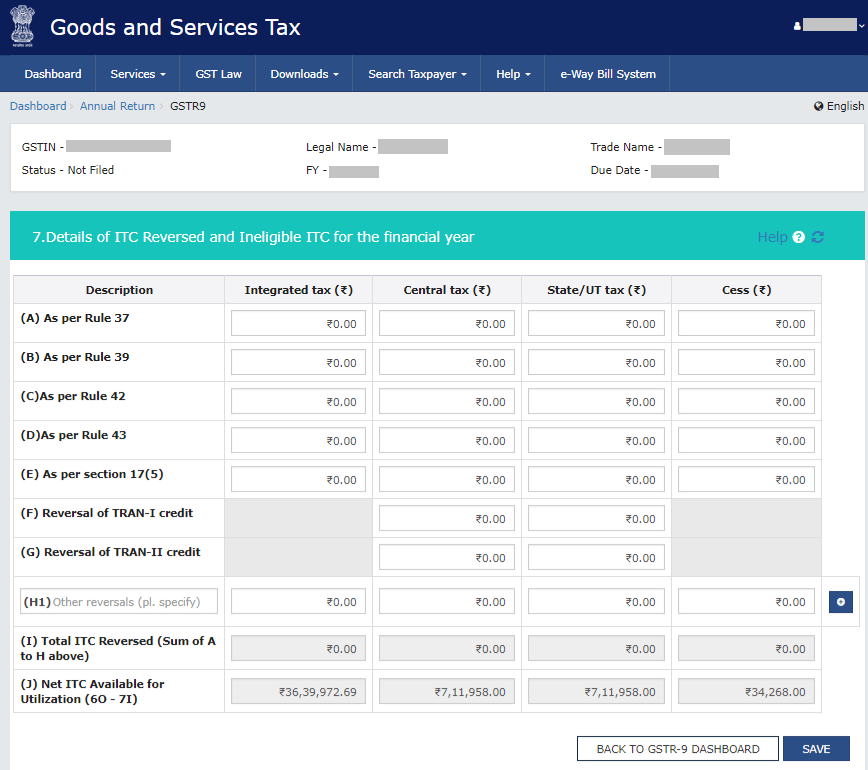
Illustration
A. Reversal of Input Tax Credit as per Rule 37, which applies when the invoice amount is not paid within 180 days.
B. Reversal of Input Tax Credit as per Rule 39, relating to Credit Notes issued to an ISD for previously distributed ITC. The reversal is in proportion to the earlier distribution.
C. Reversal of Input Tax Credit as per Rule 42, pertaining to ITC used for exempt supplies and personal purposes.
D. Reversal of ITC on capital goods used for exempt supplies and non-business purposes.
E. Reversal of ITC on supplies blocked under Section 17(5) of the CGST Act.
F. Details of reversal of transitional credit claimed and reported earlier in Tables 6K and 6L.
G. Situations where TRAN-II credit needs to be reversed, including failure to pass on benefits and excess/wrongly availed credit.
H. Any ITC reversed through FORM ITC-03, filed when opting for Composition Scheme or when taxable supply becomes exempt.
I. Sum of all ITC reversal amounts calculated in A to H.
J. The difference between the total ITC available for utilization (from Table 6O) and the total ITC reversed (from Table 7I).
Table 8: Other ITC related information
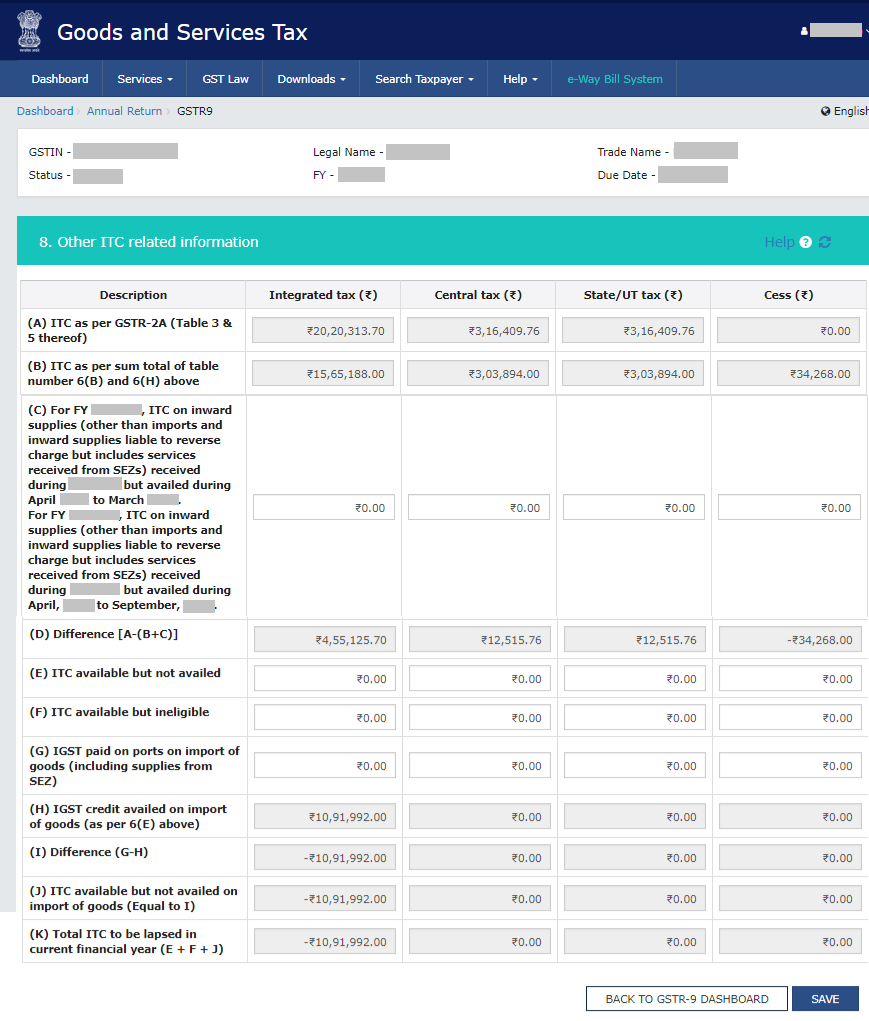
Illustration
A. Auto-populated total credit available for inward supplies (excluding imports and reverse charge) reflected in GSTR-2A (Table 3 & 5).
B. Auto-populated input tax credit declared in Table 6B and 6H.
C. Aggregate value of ITC availed on inward supplies in the financial year but claimed in the next financial year within the specified period under Section 16(4) of the CGST Act.
D. Positive value shows short claim of ITC. Negative value indicates excess ITC claimed in GSTR-3B compared to GSTR-2A.
E. Credit available in GSTR-2A but not claimed in GSTR-3B.
F. Credit available but not claimed in GSTR-3B due to ineligibility.
G. Aggregate value of IGST paid during imports, including supplies from SEZs.
H. Auto-populated input tax credit declared in Table 6E.
I. Indicates the variance between IGST paid on imports and IGST credit availed.
J. This ITC, although available (IGST paid on import), has not been claimed or utilized in the GST return (GSTR-3B).
K. Sum of ITC amounts that will lapse for the current financial year.
Table 9: Details of tax paid as declared in returns filed during the financial year
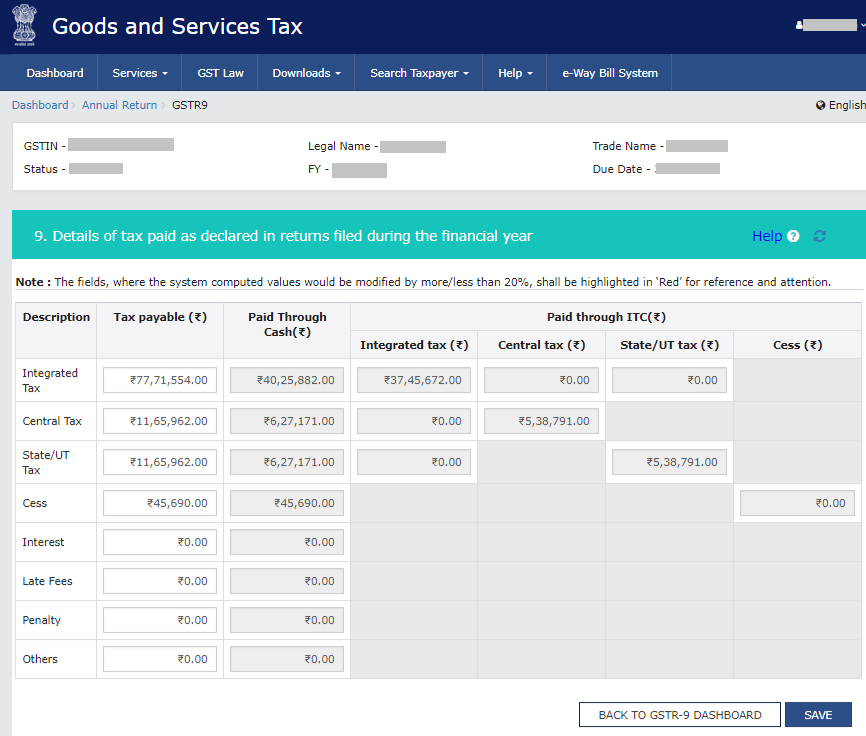
Illustration
Summary of tax payments and associated charges (IGST, CGST, SGST, UTGST, Cess, Interest, Late fee, Penalty, etc.) made during the financial year as declared in the filed returns.
Table 10,11,12 &13: Details of the previous Financial Year's transactions reported in next Financial Year
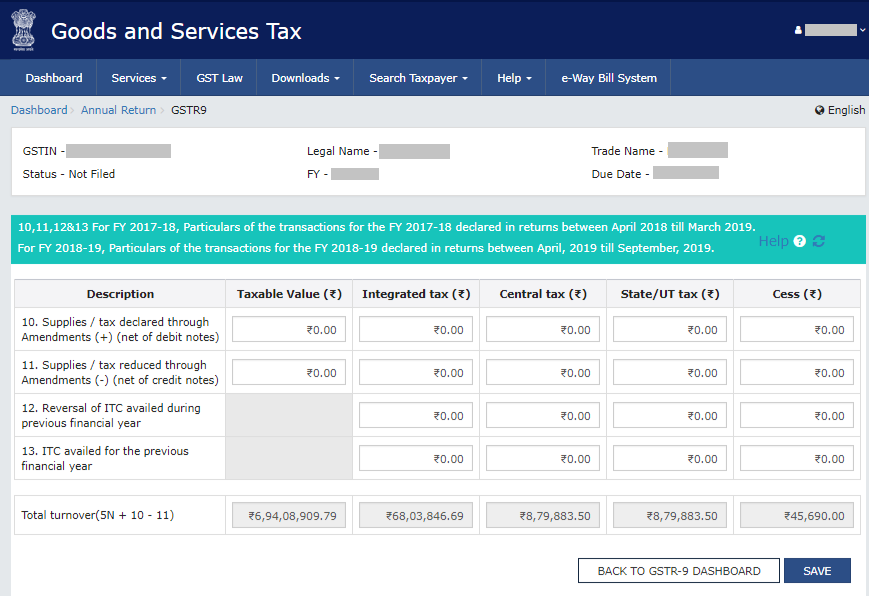
Illustration
Table 10: Declarations of additions or amendments to previously reported supplies or tax in returns filed for April 2023 to Oct 2023 (FY 2022-23).
Table 11: Declarations of reductions or amendments (net of credit notes) to previously reported supplies or tax in returns filed for April 2023 to Oct 2023 (FY 2022-23).
Table 12: Aggregate value of ITC reversal for excess claimed in FY 2022-23 but reversed in returns filed for April 2023 to Nov 2023.
Table 13: Details of ITC for goods or services received in FY 2022-23, but ITC for the same availed in returns filed for April 2023 to Nov 2023.
Table 14: Differential tax paid on account of declaration in table no. 10 & 11
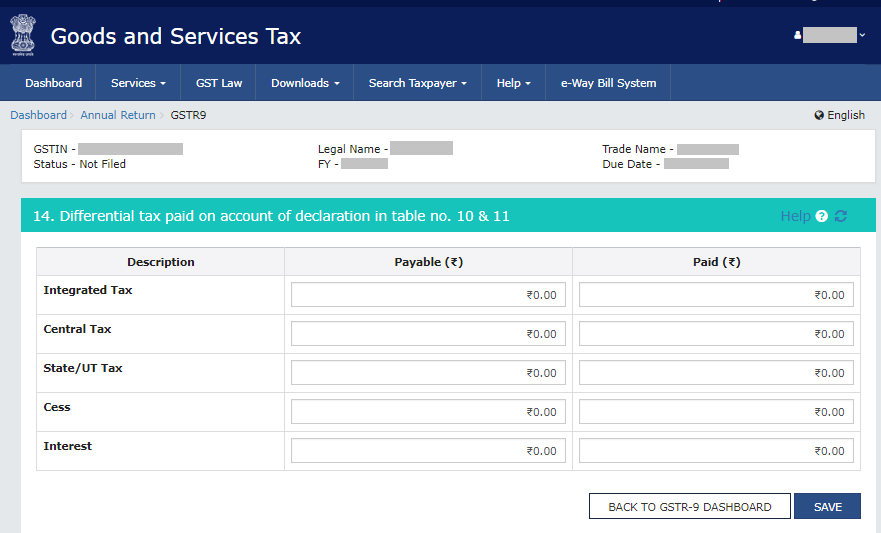
Illustration
IGST, SGST/UTGST, Cess, and Interest that are required to be paid after furnishing details in Table 10 and 11.
Table 15: Particulars of Demands and Refunds
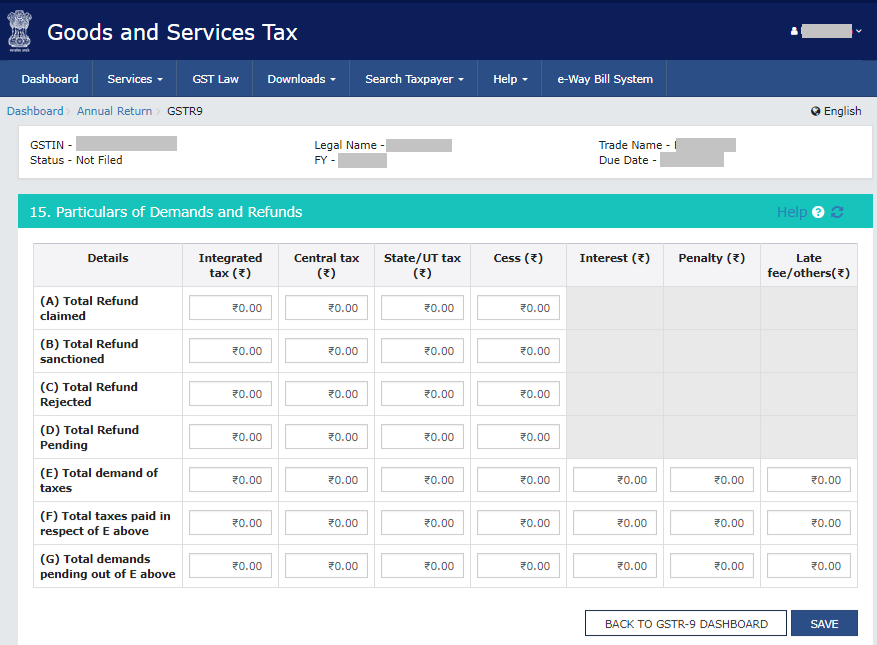
Illustration
Refund Details
A. Aggregate value of all refund claims filed in the financial year.
B. Aggregate value of refunds for which sanction orders have been issued.
C. Aggregate value of refunds rejected during the financial year.
D. Aggregate value of refunds pending processing, excluding provisional refunds.
Demands Details
E. Aggregate value of demands for taxes with confirmed orders by the adjudicating authority.
F. Aggregate value of taxes paid out of the confirmed demand (15E).
G. Aggregate value of demands still pending recovery from the confirmed demands (15E).
Table 16: Supplies received from Composition taxpayers, deemed supply by job worker and goods sent on approval basis
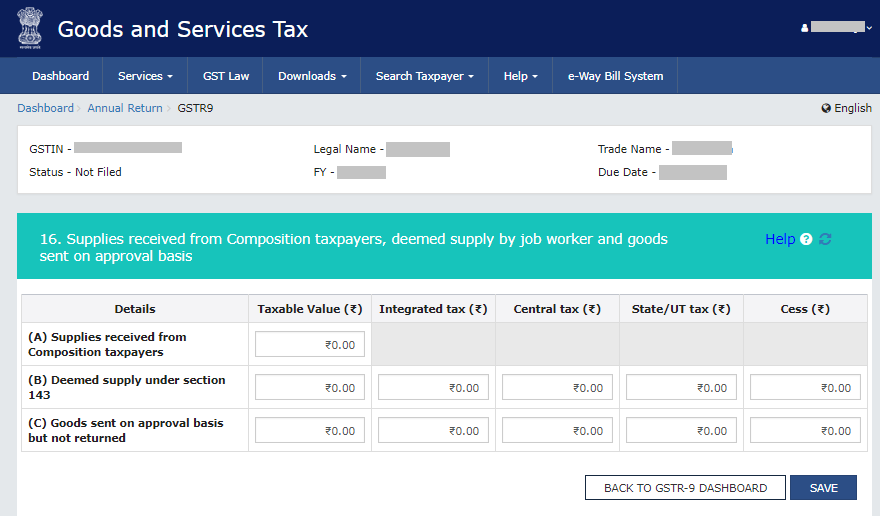
Illustration
A. Aggregate value of supplies received from taxpayers under the Composition Scheme.
B. Aggregate value of deemed supplies from the principal to the job-worker under Section 143(3) and (4) of the CGST Act.
C. Aggregate value of deemed supplies for goods sent on approval basis but not returned to the principal supplier within 6 months.
Table 17: HSN wise summary of Outward Supplies
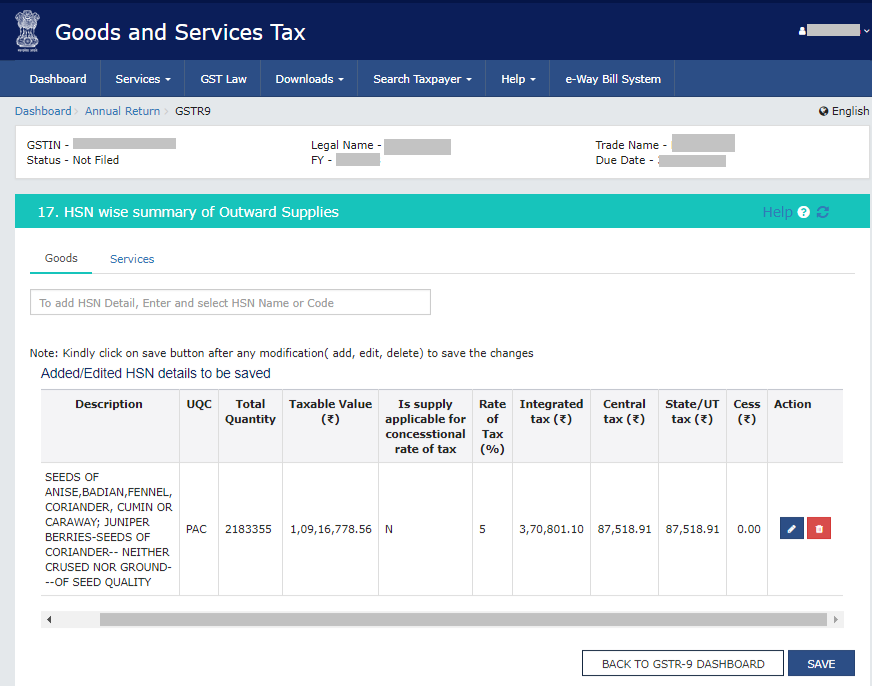
Illustration
Report summary details of outward supplies categorized by HSN code.
Furnish Unit Quantity Code (UQC) details for goods supplies.
Report quantity net of returns for accurate representation.
Table 18: HSN wise summary of Inward Supplies
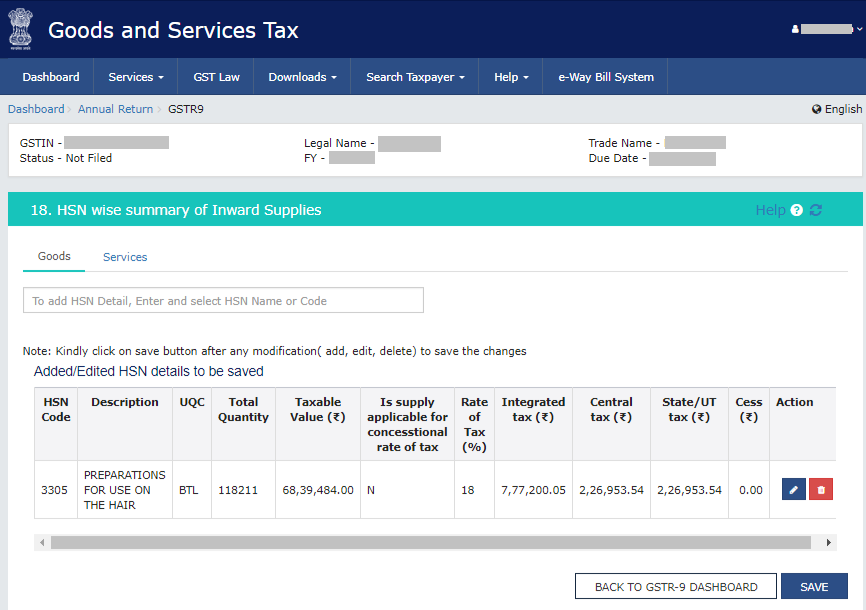
Illustration
Report summary details of inward supplies categorized by HSN code.
Furnish Unit Quantity Code (UQC) details for goods received.
Report quantity net of returns for accurate representation.
|
Note : Mandatory for FY 2021-22 onward: 6-digit HSN for taxpayers with Aggregate Turnover above 5 Cr. 4-digit HSN for all B2B supplies for taxpayers with up to 5 Cr. |
- Once you have entered all details, click the relevant PREVIEW DRAFT GSTR9 (PDF) or (EXCEL) button. This will download the draft Summary page of Form GSTR-9 for your review.
- Click the COMPUTE LIABILITIES button for computation of late fees (if any).
- Once the status of Form GSTR-9 is Ready to File and liabilities are calculated, Table 19 Late fee payable and paid tile gets enabled.
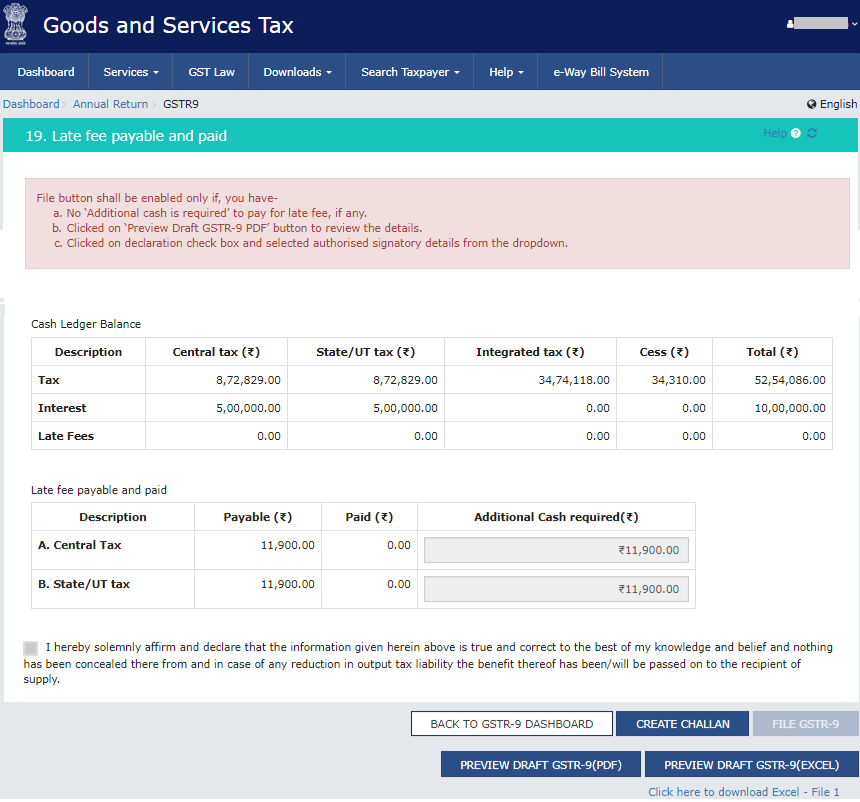
- Click on "Proceed to File" button.
- Select the Declaration checkbox.
- Select the Authorized Signatory from the drop-down list.
- Click the FILE GSTR-9 button.
- Click the YES button.
- The Submit Application page will be displayed. Click the FILE WITH DSC or FILE WITH EVC button.
- The success message will be displayed and ARN is displayed. Status of the Form GSTR-9 return changes to “Filed”.
- After Form GSTR-9 is filed. Message will be displayed to directly navigate to Form DRC-03, to pay additional liabilities, if any declared in Form GSTR-9.







 CAclubindia
CAclubindia
